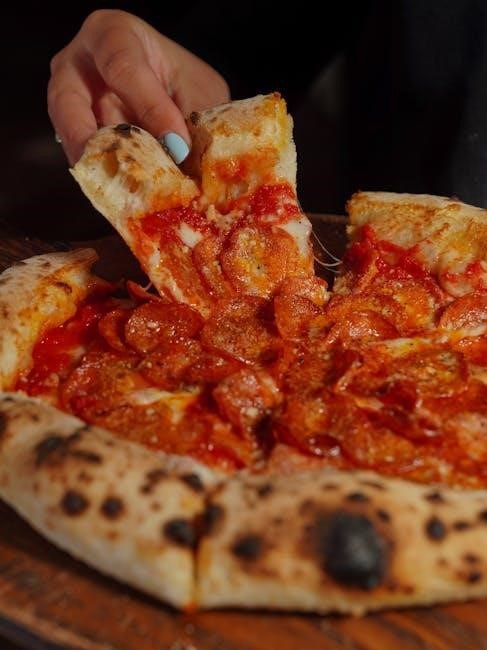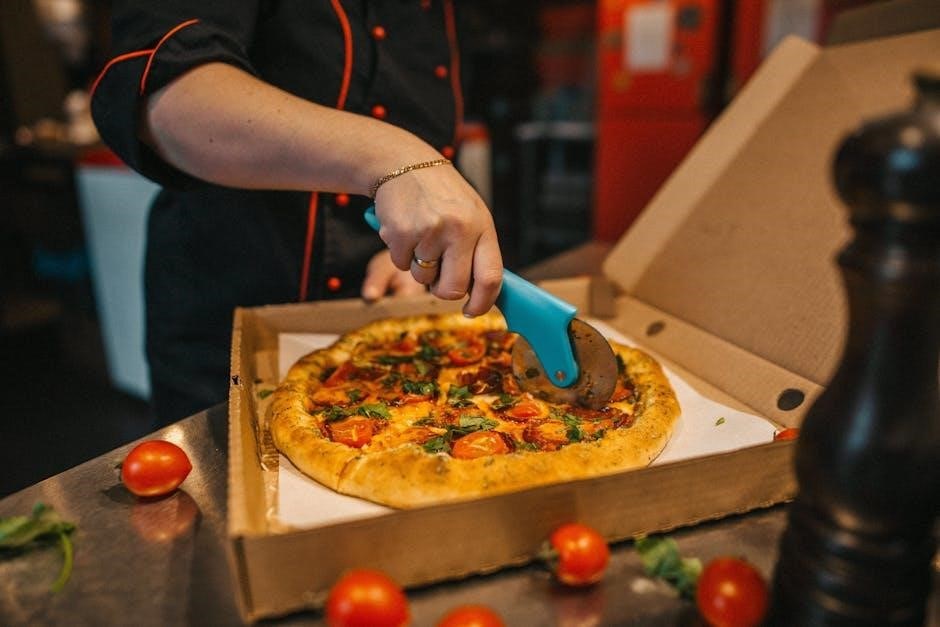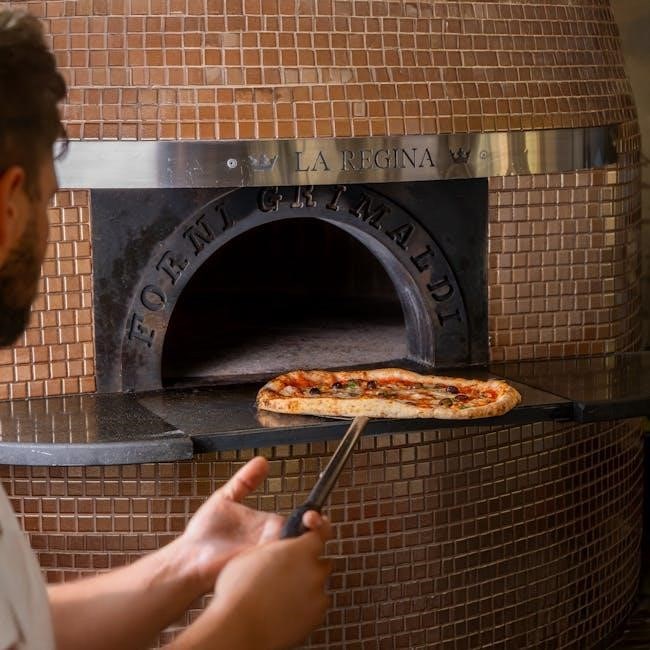Trader Joe’s Pizza Dough is a popular, convenient pre-made dough offering homemade pizza ease. Loved for its taste, versatility, and affordability, it’s a favorite for quick meals.
1.1 Popularity of Trader Joe’s Pizza Dough
Trader Joe’s Pizza Dough has gained immense popularity due to its convenience and versatility. Its pre-made format allows home cooks to create delicious pizzas quickly. Social media platforms and cooking shows frequently feature it, showcasing its ease of use. Many praise its taste, which rivals homemade dough, making it a favorite for both novices and experienced cooks. The dough’s adaptability for various recipes, from classic pizzas to creative dishes, further boosts its appeal. Its affordability and availability in Trader Joe’s stores have made it a staple in many households, perfect for quick and satisfying meals.
1.2 Key Features of Trader Joe’s Pizza Dough
Trader Joe’s Pizza Dough is renowned for its soft, elastic texture and ease of use. It comes pre-made, saving time on preparation and kneading. The dough is ready to roll out after a short resting period, making it ideal for quick meals. Its mild, slightly yeasty flavor pairs well with a variety of toppings. Nutritionally, it provides a balanced mix of carbohydrates, protein, and fats, with one serving containing 130 calories. The dough is also budget-friendly and widely available in Trader Joe’s stores. Its versatility allows it to be used for pizzas, calzones, and even breadsticks, making it a versatile kitchen staple.

Step-by-Step Instructions for Using Trader Joe’s Pizza Dough
Using Trader Joe’s Pizza Dough involves a simple process: let the dough rest, preheat your oven, shape the dough, add toppings, and bake until golden. Easy and quick!
2.1 Preparing the Dough
Preparing Trader Joe’s Pizza Dough begins with letting it rest at room temperature for 20 minutes to ensure it becomes pliable and easy to shape. Lightly flour your work surface and hands to prevent sticking. Gently roll or stretch the dough to your desired thickness and shape. Avoid overworking the dough, as this can make it tough. Once shaped, it’s ready for toppings or further preparation. Proper handling ensures the dough retains its texture and flavor, making it ideal for crafting delicious homemade pizzas or other creations.
2.2 Preheating the Oven
Preheating the oven is a crucial step when using Trader Joe’s Pizza Dough. Set your oven to 450°F to 500°F, depending on your preference for crust crispiness. If you’re using a pizza stone, place it in the oven during preheating to ensure even heat distribution. Let the oven preheat for at least 30 minutes to achieve the right temperature. A preheated oven helps the dough cook evenly and quickly, resulting in a crispy crust. Proper preheating is essential for achieving the best texture and flavor in your homemade pizza.
2.3 Shaping the Dough
Once the dough is at room temperature, lightly flour your hands and work surface to prevent sticking. Gently stretch or roll the dough into your desired shape, such as a circle, rectangle, or square. For a uniform thickness, spin the dough in the air or use a rolling pin. Avoid overworking the dough, as it can become tough. If the dough resists stretching, let it rest for a few minutes before continuing. Proper shaping ensures even cooking and a crispy crust. For a crisper crust, stretch the dough thinly, or keep it thicker for a chewier texture.
Cooking Methods for Trader Joe’s Pizza Dough
Trader Joe’s pizza dough can be baked in a conventional oven at 450°F for 10-12 minutes, grilled for a smoky flavor, or cooked on a sheet pan or oven rack for a crisper crust. Preheating properly ensures even cooking. Higher temperatures yield a crispy base.
3.1 Baking in a Conventional Oven
Preheat your oven to 425-450°F (220-230°C). Remove the dough from packaging and let it rest at room temperature for 20 minutes to ensure easier handling. Lightly flour your work surface and roll out the dough to your desired thickness. Transfer the dough to a greased baking sheet or pizza stone. Top with your favorite ingredients, avoiding overload to prevent sogginess. Bake for 10-12 minutes, or until the crust is golden brown and the cheese is bubbly. Rotate the pizza halfway through for even cooking. Keep an eye on the pizza during the last few minutes to avoid burning. This method ensures a crispy crust and perfectly cooked toppings.
3.2 Grilling the Pizza Dough
Grilling Trader Joe’s Pizza Dough adds a smoky flavor and crispy texture. Preheat your grill to medium-high heat (around 425-450°F). Roll out the dough thinly to prevent burning. Lightly brush both sides with olive oil to avoid sticking. Place the dough on the grill and cook for 2-3 minutes, until the bottom is golden. Flip gently and top with sauce, cheese, and toppings. Cook for another 2-3 minutes, until the crust is golden and the cheese is melted. For a crisper crust, place a pizza stone on the grill. Keep an eye on the dough to prevent burning, as grill heat can vary. This method offers a unique, charred flavor to your pizza.
3.3 Alternative Cooking Methods
Beyond oven and grill, Trader Joe’s Pizza Dough can be cooked in alternative ways for unique results. Air fryers offer a crispy crust: preheat to 400°F, cook for 5-7 minutes. Skillet cooking on the stovetop is another option—preheat a skillet over medium heat, add oil, and cook for 3-4 minutes per side until golden. For a crispy crust, bake directly on a preheated pizza stone. Another method is using a toaster oven for even cooking at 425°F for 8-10 minutes. These alternatives provide creative ways to enjoy pizza with a variety of textures and flavors, perfect for those without an oven or seeking a different twist.

Nutrition Information
Trader Joe’s Pizza Dough offers a balanced nutritional profile. One serving contains 130 calories, 26g carbs, 1.5g fat, 4g protein, and essential minerals like calcium and iron.
4.1 Calorie and Nutrient Breakdown
Trader Joe’s Pizza Dough provides a balanced nutritional profile per serving. One serving (half the package) contains 130 calories, 26g of carbohydrates, 1.5g of fat, and 4g of protein. It is also a good source of essential minerals, including 2mg of iron, 54mg of potassium, and 21mg of calcium. Additionally, it contains 180mg of sodium and 1g of fiber, making it a versatile option for various dietary needs. This breakdown highlights its suitability for health-conscious individuals seeking a convenient yet nutritious base for homemade pizzas or other recipes.
4.2 Health Benefits and Considerations
Trader Joe’s Pizza Dough offers several health benefits, including essential nutrients like iron, potassium, and calcium, which support overall well-being. Its relatively low calorie and fat content makes it a healthier alternative for homemade pizzas. However, it contains 180mg of sodium per serving, which should be considered for those monitoring sodium intake. Additionally, with only 1g of fiber, it may not be ideal for those seeking high-fiber options. Moderation is key, especially for individuals managing conditions like high blood pressure. Balancing toppings with fresh vegetables can enhance its nutritional value, making it a versatile choice for health-conscious meals.

Creative Recipes Using Trader Joe’s Pizza Dough
Transform Trader Joe’s Pizza Dough into delicious creations such as calzones, sheet pan pizza, stuffed crust pizza, pizza dough cheese sticks, or even homemade focaccia.
- Calzones
- Sheet Pan Pizza
- Stuffed Crust Pizza
- Pizza Dough Cheese Sticks
5.1 Classic Cheese Pizza
A simple yet delicious option, the classic cheese pizza is a crowd-pleaser. Preheat your oven to 450°F and let the dough sit at room temperature for 20 minutes. Roll it out to your desired thickness and place on a floured surface or pizza stone. Spread a thin layer of tomato sauce over the dough, leaving a small border around the edges. Sprinkle shredded mozzarella cheese generously. Bake for 10-12 minutes until the crust is golden and the cheese is bubbly. Remove, let cool slightly, and enjoy a perfectly cooked, cheesy pizza with minimal effort!
5.2 Stuffed Crust Pizza
Create a stuffed crust pizza for an extra cheesy twist. Preheat your oven to 450°F and let the dough sit at room temperature for 20 minutes. Roll out the dough into a circle or rectangle, depending on your preference. Place it on a floured pizza pan or baking sheet. Spread a thin layer of pizza sauce in the center, leaving a 1-inch border around the edges. Sprinkle shredded mozzarella cheese over the sauce. Fold the edges of the dough over the cheese, sealing tightly to form a stuffed crust. Add additional toppings if desired and bake for 12-15 minutes until golden. Enjoy the gooey, cheesy surprise in every bite!
5.3 Pizza Dough Cheese Sticks
Transform Trader Joe’s Pizza Dough into delicious cheese sticks for a quick snack. Preheat your oven to 500°F. Roll out the dough on a floured surface to your desired thickness. Sprinkle shredded mozzarella cheese evenly over half of the dough, leaving a small border. Fold the dough in half to enclose the cheese, pressing gently to seal. Cut into strips and place on a baking sheet lined with parchment paper. Brush with olive oil and bake for 10-12 minutes, until golden. Serve warm with marinara sauce for dipping. This easy recipe offers a tasty, cheesy treat perfect for any occasion!

Common Mistakes to Avoid
Overworking the dough can make it tough, while incorrect oven temperature may prevent proper crisping. Avoid overloading with toppings to ensure even cooking and a balanced flavor.
6.1 Overworking the Dough
Overworking the dough is a common mistake that leads to a dense, tough crust. When Trader Joe’s pizza dough is manipulated excessively, the gluten activates, making it less pliable and resulting in a hard texture. To avoid this, handle the dough gently, stretching or rolling it just enough to achieve the desired shape. Allow it to rest if it becomes too tight, ensuring a lighter and airier crust. This step is crucial for maintaining the dough’s natural elasticity and achieving a perfectly baked pizza crust every time. Proper handling ensures a delicious, homemade pizza experience with minimal effort.
6.2 Incorrect Oven Temperature
Using an incorrect oven temperature can significantly affect the quality of your Trader Joe’s pizza dough. If the oven is too hot, the crust may burn before the toppings are fully cooked. Conversely, a temperature that’s too low can result in a doughy, undercooked crust. The ideal temperature for baking Trader Joe’s pizza dough is between 425°F and 450°F. Preheating the oven properly and ensuring it reaches the correct temperature before placing the dough inside is essential. This step ensures a crispy crust and evenly cooked toppings, making your homemade pizza experience more enjoyable and satisfying. Proper temperature control is key to achieving perfection. Always double-check the oven temperature before baking for the best results.
6;3 Overloading with Toppings
Overloading Trader Joe’s pizza dough with too many toppings can lead to a soggy crust and uneven cooking. The dough may struggle to hold heavy or excessive toppings, causing it to stretch or tear. This can also result in undercooked areas, as the toppings may block heat from reaching the crust. To avoid this, use a moderate amount of toppings and balance heavier ingredients with lighter ones. For example, pair robust meats like pepperoni or sausage with fresh, lightweight toppings like spinach or mushrooms. This ensures a crispy crust and evenly distributed flavors, making your pizza more enjoyable and visually appealing. Moderation is key to achieving the perfect balance of taste and texture.
